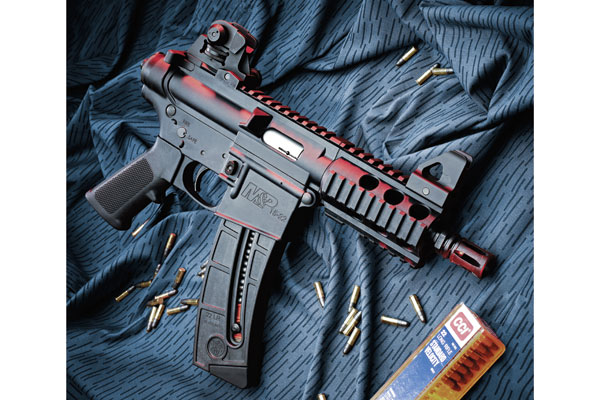
The dizzying world of executive protection services in our post-9/11 world has changed the way weapons are used. Constant mounting and dismounting of vehicles have increased the demand for compact PDWs. The cramped confines of the embassy limousine has pushed the micro-carbine well into mainstream acceptance.Behold S&W’s M&P 15 pistol, the lap dog of bodyguard-friendly ARs. But wait, security firms have to train their operators, and everyone wants to keep costs down. So now you have the M&P 15-22P. It’s a bobtailed version of the highly successful M&P 15-22 trainer.The 15-22P is a simple blowback in .22 Long Rifle. The bolt and spring are rigged with an AR-style charging handle, and the whole pistol functions with AR controls, i.e., the mag release is on the right in front of the trigger (the guard of which is swollen for use with the gloves that are all the tactical rage), bolt catch and release are on the left and the safety is on the left above the pistol grip.

VIDEO
The version as tested came with a quad rail fore-end and sported a set of detachable iron sights secured to the continuous upper rail. I believe that a holographic red-dot optic would pay dividends in the accuracy department.
There is no forward assist. But then, if the bolt won’t close by itself, you don’t want to be smashing a rimfire primer with an open bolt. That said, cold weather will thicken oils, and some brands of .22 still use a gooey lubricant that can make initial chambering slow. Better to have a bolt handle or forward assist and not need it than to need one and cuss a lot.
Many PDWs are carried on single-point slings, and the M&P is equipped with a sling swivel on the rear stump of the receiver.
Inside, it gets interesting in a hurry. As I dropped the rear pin I expected a spring to launch into my face. I was pleasantly surprised when the whole action came out of the polymer upper as a cute, self-contained unit.
The spring at first seemed curiously underpowered considering that this was a simple blowback and the bolt wasn’t overly heavy. But upon discovering that the trigger mechanism is virtually the same as an AR, I realized that the tension of the hammer spring aids in retarding the bolt. The plastic charging handle must be withdrawn at the same time as the bolt assembly, just like a real AR.
The stainless bolt rides on two rails projecting off the assembly that retains the spring and its guide rod. The front of the guide rod pierces a stud atop the bolt, which is what the charging handle grabs on to.
The bolt face is conventional, but the wide, flat chamber shoulder with proud little feed ramp has a spindly, spring-steel finger sticking out with a hook at the end: Meet Mr. Ejector. The polymer lower contains what appears to be a garden-variety AR trigger group.
I set up a Shooter’s Ridge Gorilla Bag and stapled some Shoot-N-C targets to the range’s riddled and staple-saturated plywood. The bag was used to stabilize the pistol grip, and the magazine rested on the bench forward of the bag.
The ammo selection went from sedate 40-grainers to Winchester’s hot new 26-grain tin loads, several magazines of each. After seeing that everything functioned, I conducted my usual make-it-jam protocol. The pistol was fired right side up, left side up and upside down, then limp-wristed. I had one stove-pipe with the tepid Biathlon ammo when I fired the pistol with the right side up. The trigger pull was 5½ pounds with just a bit of creep.
The CCI Select yielded best results, with a cluster a hair over three-quarters of an inch. I tried some CCI snake shot in it, which, predictably, wouldn’t cycle the action. At 10 yards the pattern was too wide to be effective, but at five yards it produced a dense pattern about paper-plate diameter. Woe be the rattler that gets in front of this load.
This is a valid training tool for folks working with real M&P 15P’s, and it’s a fun plinker. It is designed and built with Smith & Wesson’s traditional high quality and would pay for itself in short order.